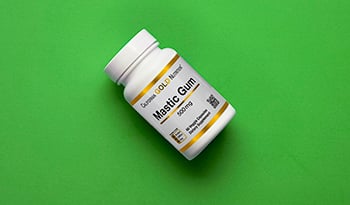5 Ways to Benefit More From Calcium Supplements

Calcium is the most abundant mineral in the body. It constitutes 1.5 to 2% of the total body weight with more than 99% of the calcium being present in the bones. In addition to its major function in building and maintaining bone and teeth, calcium is also important in the activity of many enzymes in the body. The contraction of muscles, release of neurotransmitters, regulation of heartbeat, and the clotting of blood are all dependent on calcium.
Calcium supplements are among the most popular of all-natural products, especially among women. After all, building strong bones should be a lifelong goal beginning in childhood for women as there is a strong correlation between early-life bone density and the risk of osteoporosis later in life. Here are five important considerations to get the greatest benefits from calcium supplementation at any age.
1. Get the Most out of Calcium Supplements with Vitamin D
Adequate calcium intake has an established role in maintaining bone health, primarily in very young women and the elderly. However, calcium supplementation has the best chance of actually protecting against bone loss or osteoporosis when it is combined with vitamin D and K2, and other nutrients as well. Bones are dynamic living tissue that requires nearly every essential nutrient for optimal integrity.
A detailed analysis of controlled trials with calcium supplementation alone for bone health showed only a modest benefit on bone health.1 It appears that more support is needed than just calcium alone. Boosting calcium with vitamin D provides better results. A closer examination of the Women’s Health Initiative, which enrolled more than 36,000 postmenopausal women, showed a surprising result. Many women in the study did not take dietary supplements on a regular basis. When the analysis was restricted to women who took the tablets at least 80% of the time, calcium plus vitamin D results showed significantly decreased hip fractures by 29% compared with placebo.2 This was a significant result as the vitamin D supplementation was minimal, but clearly yielded a different outcome.
2. Vitamin K2 Helps Calcium Anchor to Bone
Vitamin K2 or menaquinone is produced by bacteria and found in some fermented foods. There are several different forms of K2 based upon the number of molecules that are attached to the vitamin K backbone. MK-7 is the most important commercial form of vitamin K2. MK-7 is available as a dietary supplement derived from natto (a fermented soy food popular in Japan). Also, a three-ounce serving of natto provides 850 mcg of MK-7.
Vitamin K2 plays an important role in bone health as it is responsible for converting the bone protein osteocalcin from its inactive form to its active form. Osteocalcin is the major non-collagen protein found in our bones and in its active form, it anchors calcium into place within the bone. In a landmark major clinical study, 244 healthy postmenopausal women took either MK-7 (180 mcg per day) or a placebo for 3 years.3 Results showed MK-7 significantly improved vitamin K status and active osteocalcin levels and decreased the age-related decline in bone mineral concentration (BMC) and bone mineral density. Bone strength was also favorably affected by MK-7 – a key determinant of fracture risk. Lastly, MK-7 significantly decreased the loss in vertebral height of the lower thoracic region at the mid-site of the vertebrae. These results highlight the importance of MK-7 supplementation in postmenopausal women, but benefits are important at any age. MK-7 has the additional benefit of ensuring calcium is deposited into bone and not soft body tissues like the walls of blood vessels.
3. Maintain Balance with Magnesium
Magnesium and calcium are in many ways companion nutrients, especially in bones. Magnesium is required for proper bone mineralization as well as helps activate vitamin D.4 Taking large doses of calcium can impair the absorption of magnesium and could potentially negatively affect bone health. To ensure the proper balance of calcium to magnesium, it is generally recommended to take half as much magnesium as calcium or in other words follow a 2:1 ratio of calcium to magnesium.
4. Avoid High Intake of Dietary Factors that Impair Calcium Utilization
Sugar, salt (sodium chloride), and excess protein all negatively affect calcium utilization by promoting the urinary excretion of sugar. So if dietary intake of calcium is not sufficient, calcium will be taken from bone and then excreted in the urine. The intake of sweet beverages, including non-carbonated fruit juices and carbonated cola beverages, are significantly associated with a higher risk of fractures. Soft drink consumption is particularly harmful as they contain not only sugar but also acidic phosphates that also promote calcium excretion. An increase of one-half of a can per day of fruit juice and cola beverages more than doubles the risk of bone fractures.5
5. Does the Form of Calcium Matter?
Calcium supplements are available in capsules, tablets, chewable wafers, and liquids in a variety of different chemical forms. The two most widely used forms are calcium carbonate and calcium citrate. Either of these forms of calcium are suitable for most people. The possible exception is that calcium carbonate may not be absorbed as well as calcium citrate in people who do not produce enough stomach acid.6 But in these instances, anecdotal evidence shows that taking calcium carbonate with food can alleviate this.7 Algae, coral (fossilized), and oyster shell calcium are all sources of calcium carbonate.
Calcium bound to citrate or lactate is generally regarded as the overall best form of calcium. These substances have advantages over other forms of calcium in that they are (a) easily ionized, (b) almost completely degraded and utilized by the body, (c) have a better safety profile, and (d) able to increase the absorption of not only calcium but other minerals as well. The problem with these forms of calcium supplements is their bulk – it basically requires three to four times as many capsules or tablets to provide the same level of calcium compared to calcium carbonate sources.
Forms of Calcium, Advantages, and Disadvantages
Form | Disadvantages | Advantages |
Algae calcium | More expensive form of calcium carbonate. | May provide additional trace minerals. |
Calcium carbonate | May not be adequately absorbed in people with insufficient output of stomach acid. Should be taken with foods for maximal absorption. | Inexpensive. Easier to take in tablets or capsules because it is not as bulky as other forms. |
Calcium citrate; calcium gluconate; calcium lactate; calcium bound to other organic acids | Larger molecule is bulkier than calcium carbonate thus requiring more tablets/capsules to achieve the same dosage as calcium carbonate. | Easily absorbed regardless of the output of stomach acid. |
Calcium phosphate | May have a greater effect in blocking the absorption of iron and other minerals. | The phosphate component is also critical to bone health. Least likely to cause constipation. |
Coral calcium (calcium carbonate from fossilized coral), oyster shell calcium, dolomite, and bone meal calcium | May contain high levels of lead and other impurities. | Similar to calcium carbonate. |
Microcrystalline calcium hydroxyapatite | Poorly absorbed compared to other forms. More expensive. | Claimed to possibly exert additional benefits in bone health due to other components. |
Dosage Guidelines for Calcium
The dosage range used for supplementation generally reflects the recommended dietary allowance (RDA) for calcium. There have been many studies with calcium supplementation for bone health. From these studies it appears that an effective dosage for supplemental calcium is 600 to 1,000 mg per day for most women. Taking 1,000 mg 1,000 mg per day of calcium for bone health has produced just as good of results as 2,000 mg per day.8
Recommended Dietary Allowance for Calcium
Infants
- 0-0.5 year 400 mg
- 0.5-1 year 600 mg
Children
- 1-3 years 800 mg
- 4-6 years 800 mg
- 7-10 years 800 mg
Young Adults and Adults
- Males 11-24 years 1,200 mg
- Males 25+ years 800 mg
- Females 11-24 years 1,200 mg
- Females 24+ years 800 mg
- Pregnancy 1,200 mg
- Lactating 1,200 mg
Possible Side Effects of Calcium Supplements
Calcium supplements are generally well tolerated at doses of less than 2,000 mg. Higher dosages may increase the risk for kidney stones and soft-tissue calcification, however, neither of these two conditions have been conclusively linked to calcium supplementation.
Calcium Drug Interactions
Aluminum-containing antacids are known to ultimately lead to an increase in bone breakdown and calcium excretion. Calcium can decrease the absorption of the following drugs when taken together: bisphosphonates, etidronate (Didronel®), tetracycline antibiotics, phenytoin (Dilantin®), and thyroid hormone. If you are taking any of these drugs, you must take calcium at least two hours away from the drug. Thiazide-type diuretics can interact with calcium carbonate and vitamin D supplements, increasing the risks of hypercalcemia and hypercalciuria. Check with your physician if you are taking these drugs.
References:
- Tai V, Leung W, Grey A, Reid IR, Bolland MJ. Calcium intake and bone mineral density: systematic review and meta-analysis. BMJ 2015;351:h4183.
- Jackson R, LaCroix A, Gass M, et al. for the Women’s Health Initiative Investigators: calcium plus vitamin D supplementation and the risk of fractures. N Engl J Med 2006;354:669–683.
- Knapen MH, Drummen NE, Smit E, Vermeer C, Theuwissen E. Three-year low-dose menaquinone-7 supplementation helps decrease bone loss in healthy postmenopausal women. Osteoporos Int. 2013;24(9):2499-507
- Castiglioni S, Cazzaniga A, Albisetti W, Maier JA. Magnesium and osteoporosis: current state of knowledge and future research directions. Nutrients. 2013 Jul 31;5(8):3022-33.
- DiNicolantonio JJ, Mehta V, Zaman SB, O'Keefe JH. Not Salt But Sugar As Aetiological In Osteoporosis: A Review. Mo Med. 2018 May-Jun;115(3):247-252.
- Sakhaee K, Bhuket T, Adams-Huet B, Rao DS. Meta-analysis of calcium bioavailability: a comparison of calcium citrate with calcium carbonate. Am J Ther 1999(6):313-21.
- Heaney RP, Dowell MS, Barger-Lux MJ. Absorption of calcium as the carbonate and citrate salts, with some observations on method. Osteoporos Int. 1999;9(1):19-23.
- Elders PJ, Lips P, Netelenbos JC, van Ginkel FC, et al. Long-term effect of calcium supplementation on bone loss in perimenopausal women. J Bone Miner Res 1994;9:963–70
DISCLAIMER:This Wellness Hub does not intend to provide diagnosis...













































































 Table of Contents
Table of Contents
















